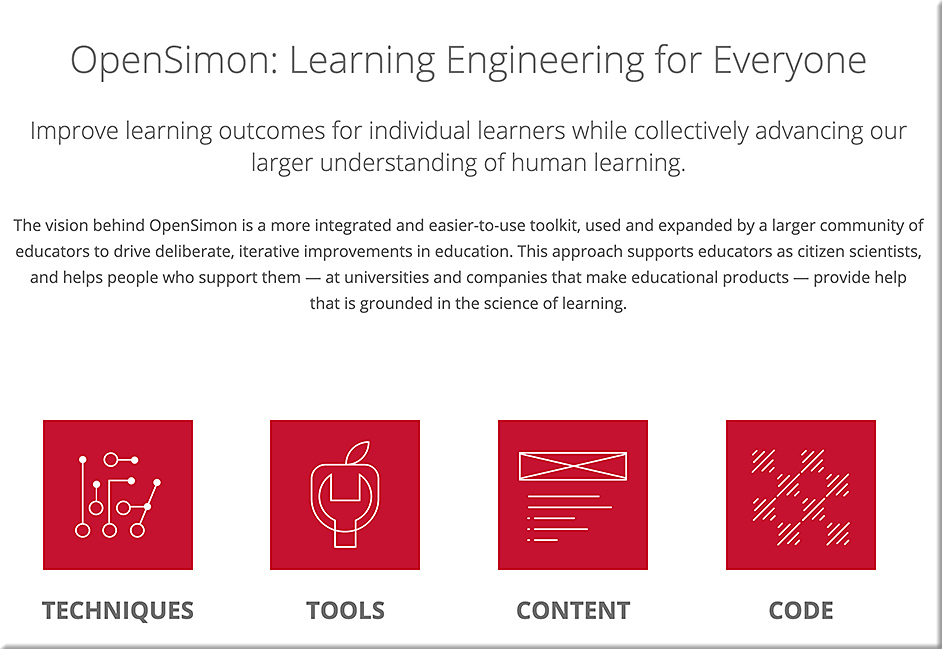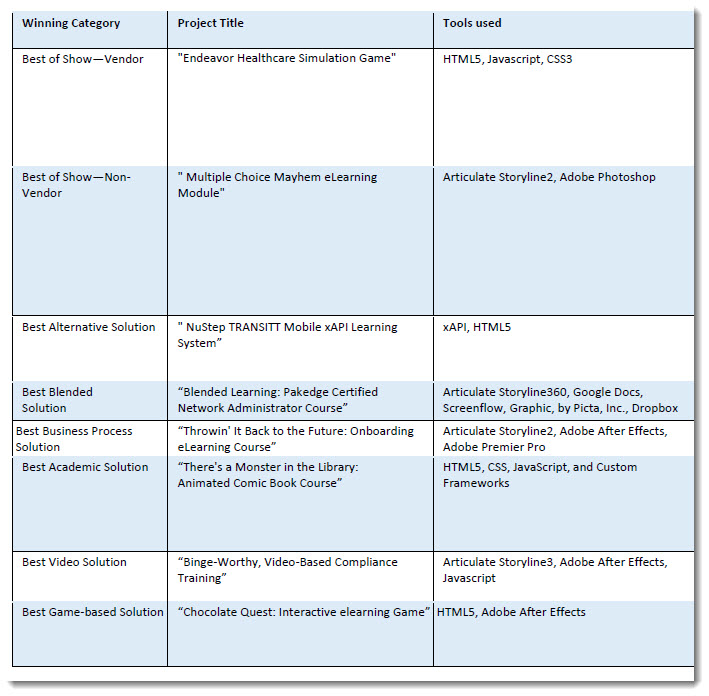Excerpts:
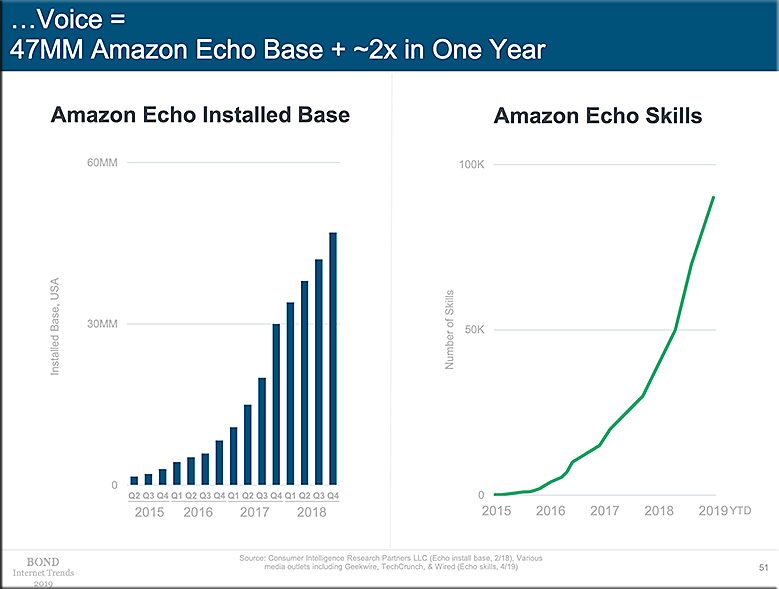


From DSC:
That last one reminded me of why I think the Living from the Living [Class] Room vision is so powerful…




Four research-based strategies every teacher should be using — from cultofpedagogy.com by Jennifer Gonzalez
Excerpt (emphasis DSC):
[Per Jennifer] Cognitive scientist Pooja Agarwal and K-12 teacher Patrice Bain have collaborated on a new book, Powerful Teaching: Unleash the Science of Learning. In the book, they go into detail about what it looks like when we actually apply four research-based “Power Tools” in the classroom: retrieval practice, spaced practice, interleaving, and feedback-driven metacognition—which is one we haven’t covered at all on this podcast. Today I’m going to talk with Pooja and Patrice about these strategies, the research behind why they work, and some ways you can start using them right away in your instruction.
Instead of assigning homework to give students practice with course material, give mini-quizzes at the start of each class that ask 3-5 questions about the prior day’s learning. These should either receive no grades or be given a very low point value, because the goal of these is to reinforce the learning, not measure or grade student work.
In her social studies classroom, Bain used to assign homework most nights, and found that not only was she spending up to two hours a night grading it, it also was doing nothing to help students retain information.
Survey: Students Choosing Online Programs Closer to Home — from campustechnology.com by Dian Schaffhauser
Mentioned in that article:
Also see:
“It’s encouraging to see that a majority of students who are studying fully online are reporting great value and satisfaction with their online programs which are largely tied to ambitious career goals,” said Todd Zipper, president and CEO of Learning House, in a prepared statement. “With an increasing population of savvier consumers with high expectations, institutions need to do better at offering more quality, diverse programs that are sensitive to cost in order to keep up with the growing demands of online college students.”
From DSC:
If, in the year 2019, most students say online learning is as good or better than face-to-face, what will they say come 2025? 2035?
Many people will still prefer to have F2F-based learning experiences no matter what year it is. That said, as the innovation continues to occur mainly in the digital/online/virtual realms, F2F will likely find it harder and harder to compete. My advice to current faculty members? Get experience teaching online — and do so as soon as you possibly can.
Belief in Learning Styles Myth May Be Detrimental — from apa.org
Many people believe learning styles predict academic and career success, study finds
Excerpts:
WASHINGTON — Many people, including educators, believe learning styles are set at birth and predict both academic and career success even though there is no scientific evidence to support this common myth, according to new research published by the American Psychological Association.
…
Previous surveys in the United States and other industrialized countries across the world have shown that 80% to 95% of people believe in learning styles. It’s difficult to say how that myth became so widespread, Nancekivell said.
Also see:
From DSC:
While I’ve heard and read through the years that there isn’t support for learning styles — and I’ve come to adopt that perspective as well due to what I’ve read, such as the items listed above — I do think that each of us has our learning preferences (as the debunker club mentioned as well). That is, how we prefer to learn about a new subject:
Along these lines…in my mind, offering learning in multiple media and in multiple ways maximizes the enjoyment of learning by a group of people. And now that we’re all into lifelong learning, the enjoyment of learning has notched waaay up in importance in my book. The more we enjoy learning, the more we enjoy life (and vice versa).
In fact, I’m getting closer to the point of putting enjoyment of learning over grades in terms of importance. Grades are a way to compare people/school systems/colleges/universities/etcetera…they are the currency of our current systems…and they are used to “incentivize” students. But such systems and methods often produce game players, not learners.
To attract talent, corporations turn to MOOCs — from edsurge.com by by Wade Tyler Millward
Excerpt:
When executives at tech giants Salesforce and Microsoft decided in fall 2017 to turn to an online education platform to help train potential users of products for their vendors, they turned to Pierre Dubuc and his team in fall 2017.
Two years later, Dubuc’s company, OpenClassrooms, has closed deals with both of them. Salesforce has worked with OpenClassrooms to create and offer a developer-training course to help people learn how to use the Salesforce platform. In a similar vein, Microsoft will use the OpenClassrooms platform for a six-month course in artificial intelligence. If students complete the AI program, they are guaranteed a job within six months or get their money back. They also earn masters-level diploma accredited in Europe.
Has Technology Made State Regional Universities Obsolete? — from campustechnology.com by Richard Rose
While SRUs do some things well, the current model is not sustainable, with students taking on enormous debt and receiving relatively little income benefit in return. Here’s how technology can help change the equation.
Excerpts (emphasis DSC):
What if the State Board of Higher Education assembled a team to create one exceptionally fine Official Texas Version of the sophomore Western Civilization course? The team would include brilliant subject-matter experts, the best graphic artists, senior instructional designers, professional film editors and sharp-eyed text editors, who could produce a 48-clock-hour video course of previously unimaginable quality.
…
When technology is fully embraced because the need for a better and cheaper product finally trumps the political protection of the status quo, the state regional university will be replaced as part of new state university systems in which local institutions will play a very different role. These new local institutions could be called Learning Satellite Centers (LSCs).
…
Much content will take the form of high-budget, high-quality multimedia productions with delivery available to all popular devices, from desktop computers to cell phones. Access to learning materials, from course movies and podcasts to reading materials, will be through an expanded electronic distribution system that will eliminate the need for paper-based academic libraries.
…
The goal of the University Center plus Learning Satellite Center model is to transfer agency back into the hands of the students, where it belongs. No longer will a self-appointed privileged group of professional academics with their arcane degrees and funny ceremonial robes be dictating to the rest of society what we all need to learn and how we need to learn it. Technology will be the great leveler and the marketplace will help individual students decide what choices are best.
Of course, a brief sketch like this one will raise many questions that cannot be explored in a single article, but the conversation must begin. The current State Regional University is not sustainable and can only be propped up by politics and sentiment for so long. Too many students are piling up huge debt to earn dubious degrees that don’t lead to marketable skills or significant economic benefits. Technology has made more effective models of higher education attainable and at a lower price. We need to fearlessly explore such models before our charming old regional campuses drift into irrelevance.
From DSC:
While the article has a bit of a bite to it (which I suppose readers of this blog would say they might see in my writings/comments as well from time to time), THIS is the kind of innovative, creative thinking that will get us somewhere. I really appreciate Richard’s article and the deep thought he was put into this topic.
In fact, as readers of this blog will know, I have long been a supporter of a TEAM-BASED approach. And listed below are some graphics that prove it — as well as this article I wrote for evolllution.com (where the “lll” stands for lifelong learning) back from 2016.
This page* lists those graphics plus the list of team members that I thought of in December 2008:
*BTW, I renamed this idea from the Forthcoming Walmart of Education
to the Forthcoming Amazon.com of Higher Education

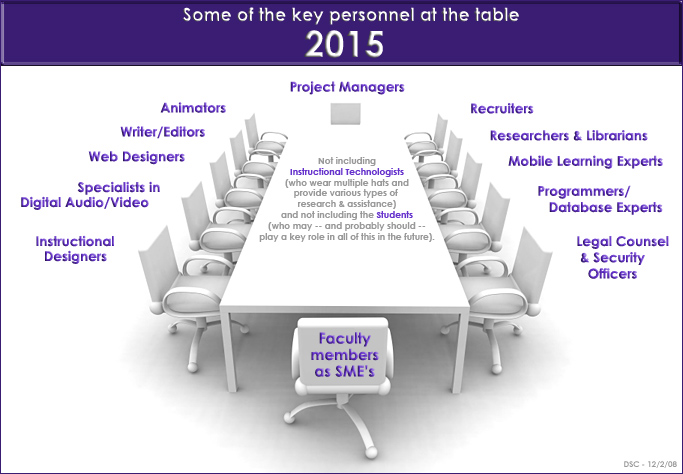
.
While I’m at it…below are a couple of ideas that I documented back in 2009 that Richard might like…
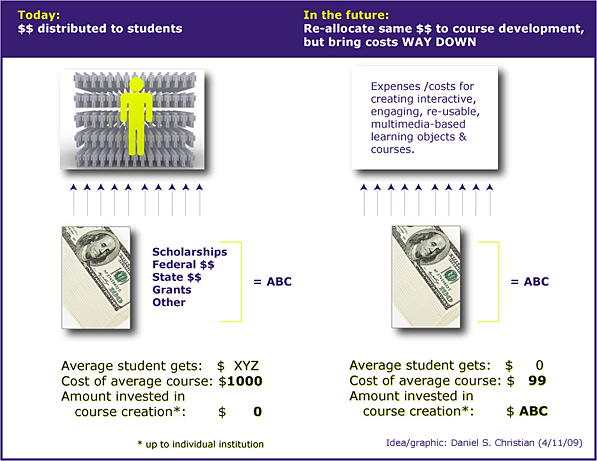
.
As of today…I would simplify that last graphic to
include a subscription model to streams of content.
Ok…one more graphic from 5/21/09 that describes what I thought would happen if institutions of traditional higher education maintained the status quo through the years. I feel pretty good about how these predictions turned out, but I wish that we would have made even more progress along these lines than we have (since the time I created this graphic).
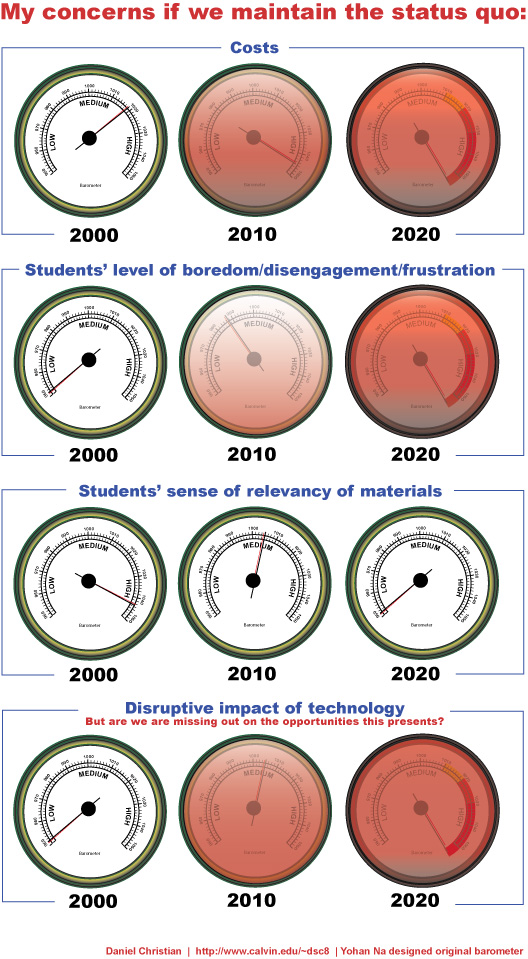
From DSC:
Re: the Learning from the Living [Class] Room vision of a next gen learning platform…
…wouldn’t it be cool if you could use your voice to ask your smart/connected “TV” type of device:
“Show me the test questions for Torts I from WMU-Cooley Law School. Cooley could then charge $0.99 for these questions.”
Then, the system knows how you did on answering those questions. The ones you got right, you don’t get asked to review as often as the ones you got wrong. As you get a question right more often, the less you are asked to answer it.
You sign up for such streams of content — and the system assesses you periodically. This helps a person keep certain topics/information fresh in their memory. This type of learning method would be incredibly helpful for students trying to pass the Bar or other types of large/summative tests — especially when a student has to be able to recall information that they learned over the last 3-5 years.
Come to think of it…this method could help all of us in learning new disciplines/topics throughout our lifetimes. Sign up for the streams of content that you want to learn more about…and drop the (no-longer relevant) subscriptions as needed..

With flip of a giant ceremonial switch, CMU starts effort to energize ‘learning engineering’ — from edsurge.com by Jeff Young
Excerpt:
Pittsburgh, PA—For a moment this week, the provost of Carnegie Mellon University looked a bit like a game show host as he grabbed the lever of an oversized switch and called on an audience to join him in a countdown—“5, 4, 3, 2, 1.” Then, he toggled the cardboard lever and declared open a new website, one that gave away software that took more than $100 million in grant funding to develop.
It was an unusually theatrical moment for a gathering to announce the release of software tools to help professors improve their teaching. But the organizers were playfully acknowledging the size of their project’s ambition—which they hope will spark a more data-driven and experimental approach to teaching at colleges around the country. And the flair was fitting, since success will end up being based not so much on how well the software works, but on how well its creators can attract momentum to their cause—and change the culture of the academic profession to make teaching an area professors are excited to make discoveries around.
…
Plenty of others have tried in the past to bring the principles of engineering to college teaching, though with limited success. In fact, the effort at Carnegie Mellon is named for Herbert Simon, a longtime professor at Carnegie Mellon who won a Nobel Prize in economics and devoted his energy and academic capital to trying to spread his ideas about turning teaching from a solo sport to a team effort. But it didn’t catch on widely in his lifetime.
From DSC:
…and devoted his energy and academic capital to trying to spread his ideas about turning teaching from a solo sport to a team effort. But it didn’t catch on widely in his lifetime.
Why do you supposed getting faculty members to use a team-based approach is so difficult? We really need to look at that, especially if institutions of higher education are going to keep increasing how much it costs to take courses at their schools — and all the while placing the emphasis on research…not teaching.
Like using an indexing fund in investing — vs. a hand-picked set of stocks — a team-based approach will be more effective the majority of the time. How can it not? There are simply too many skillsets/interests needed, especially as teaching and learning continues to move more online.
“Learning by doing appears to have a 6x better [outcome] than learning by watching or reading,” Koedinger said. He and his colleagues published an academic paper with the finding called “Learning is Not a Spectator Sport.”
Also see:
From DSC:
Here’s a ~4 minute piece from CBS News re: student loan debt.
Here are two excerpts from that video:
From DSC to potential college students:
You need to know that the ramifications of this type of debt can last for decades! Do everything you possibly can to either not borrow anything or to minimize these types of loan amounts.
This is another reason why the United States desperately needs a ***next generation learning platform*** — one that’s convenient, very inexpensive, and one that can also help people quickly reinvent themselves! One that is highly social, features human Subject Matter Experts (SME’s), and is backed up by #AI – based apps/features as well.
Along these lines…no longer are we running sprints (i.e., get a 4-year degree and you’re done). We’re now all running marathons (i.e., we’re now into lifelong learning in order to stay relevant and employed).
Also, the following item was announced today:
Also see:
From DSC:
Along these lines, I don’t think Cengage/McGraw-Hill will be the largest company on the Internet by 2030 as predicted by Thomas Frey (a prediction I think he’s right on with…by the way). They were on watch when the prices of learning-related materials soared through the years. As such, they’ve likely burned through a great deal of good will…but we’ll see. They might be able to persuade myself and others that they’re the platform of choice for the future. Time will tell I guess.
Coursera raises $103 million to prepare online learners for the ‘fourth industrial revolution’ — from venturebeat.com by Paul Sawers
Excerpts (emphasis DSC):
Founded in 2012, Coursera is one of a number of well-funded MOOCs — massive open online courses — to emerge. Coursera partners with universities and other educational institutions to deliver online courses to 40 million students, covering subjects like technology, business, science, and even autonomous cars.
…
“The fourth industrial revolution, marked by advancements in automation and artificial intelligence, is dramatically reshaping our lives, businesses, and jobs,” noted Coursera CEO Jeff Maggioncalda. “Coursera is at the forefront of preparing individuals, companies, and governments to meet that challenge head-on and turn this disruption into opportunity. The additional funding gives us the resources and flexibility to further expand internationally and to accelerate the development of a learning platform that currently serves 40 million learners, 1,800 businesses, and over 150 top universities.”
A growing repository of useful design tools, from accessibility and AR to wireframing and 3D modeling software.
? Awesome Design Toolshttps://t.co/qo5wAU9D4d pic.twitter.com/THIYPLmH0c
— Smashing Magazine (@smashingmag) April 10, 2019
The finalized 2019 Horizon Report Higher Education Edition (from library.educause.edu) was just released on 4/23/19.
Excerpt:
Key Trends Accelerating Technology Adoption in Higher Education:
Short-Term—Driving technology adoption in higher education for the next one to two years
Mid-Term—Driving technology adoption in higher education for the next three to five years
Long-Term—Driving technology adoption in higher education for five or more years
Minerva’s Innovative Platform Makes Quality Higher Ed Personal and Affordable — from linkedin.com by Tom Vander Ark
Excerpt:
The first external partner, the Hong Kong University of Science and Technology (HKUST), loved the course design and platform but told Nelson they couldn’t afford to teach 15 students at a time. The Minerva team realized that to be applicable at major universities, active learning needed to be scalable.
Starting this summer, a new version of Forum will be available for classes of up to 400 at a time. For students, it will still feel like a small seminar. They’ll see the professor, themselves, and a dozen other students. Forum will manage the movement of students from screen to screen. “Everybody thinks they are in the main room,” said Nelson.
…
Forum enables real-time polling and helps professors create and manage breakout groups.
…
Big Implications
With Forum, “For the first time you can deliver better than Ivy League education at absurdly low cost,” said Nelson.
Online courses and MOOCs just repackaged the same format and just offered it with less interaction. As new Forum partners will demonstrate, “It’s possible to deliver a year of undergraduate education that is vastly superior for under $5,000 per student,” added Nelson.
He’s excited to offer a turnkey university solution that, for partners like Oxford Teachers Academy, will allow new degree pathways for paraprofessionals that can work, learn, and earn a degree and certification.
Perhaps another piece of the puzzle is falling into place…
In the last 10 years, I have written over 2000 provincial certification exam questions and reviewed more than 10000 questions written by tech writers. This resource is the best I have seen and I endorse every tip. What an excellent job by @caranorth11 and @mshEducation https://t.co/1nTpOaU6xt
— Taruna Goel (@write2tg) April 2, 2019
If you missed our presentation (@mshEducation) at #LSCon about writing better multiple-choice test items, you can get the resources here: https://t.co/I4k6Vxa0Rk
We've also been asked to do an encore via webinar to dive into this again. Once we have it finalized, we will share. pic.twitter.com/WlkGU9Pjlr— Cara North #ATD2019 (@caranorth11) April 1, 2019
